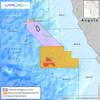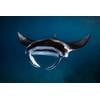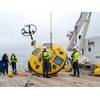Deep Side to Chilean Devil Rays
Thought to dwell mostly near the ocean's surface, Chilean devil rays (Mobula tarapacana) are most often seen gliding through shallow, warm waters. But a new study by scientists at Woods Hole Oceanographic Institution (WHOI) and international colleagues reveals that these large and majestic creatures are actually among the deepest-ocean animals. Extracts follow:
"So little is known about these rays," said Simon Thorrold, a biologist at WHOI and one of the authors of the paper, also published in the journal 'Nature Communications'. "We thought they probably travelled long distances horizontally, but we had no idea that they were diving so deep. That was truly a surprise."
WHOI explain that researchers utilized pop-up satellite archival transmitting tags to record the movement patterns of 15 Chilean devil rays in the central North Atlantic Ocean during 2011 and 2012. The tags, which stay on the animals for up to 9 months, also measure water temperature, depth, and light levels of the waters. Once the tags pop off, they float to the surface and beam data via the ARGO satellite system back to computers on shore.
Devil rays, which can grow as large as four meters (13 feet) across, are ocean nomads travelling large areas of the ocean. Dive data from the tags showed individuals also routinely descended at speeds up to 6 meters per second (13.4 miles per hour) to depths of almost 2,000 meters (1.24 miles) in water temperatures less than 4 degrees Celsius (39.2 degrees Fahrenheit).
The deep dives generally followed two distinct patterns. The most common involved descent to the maximum depth followed by a slower, stepwise return to the surface with a total dive time of 60 to 90 minutes. The tagged rays generally only made one such dive during a 24-hour period. In the second dive pattern, individuals descended and then remained at depths of up to 1,000 meters (3,280 feet) for as long as 11 hours.
Participants & Funding
Researchers from the King Abdullah University of Science and Technology (KAUST) and Massachusetts Marine Fisheries also contributed to the study.
Funding for this research came from the National Science Foundation, The Harrison Foundation, Rodney and Elizabeth Berens, the King Abdullah University of Science and Technology, Portuguese Foundation for Science and Technology/ Ministry of Education and Science, the LARSyS Strategic Project, and WHOI.
Source: WHOI













 August 2025
August 2025



